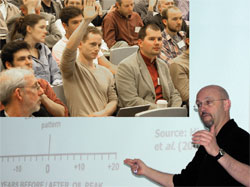 Photo: Richard Cohen Alex Farrell of the Energy Resources Group at UC Berkeley gives a presentation on “The Race for 21st Century Fuels”, while the audience (inset) listens attentively and waits to ask questions. |
Art Rosenfeld, commissioner of the California Energy Commission, described that state’s recent successes in reducing electricity use compared to the US as a whole. This was accomplished in part through improved utility efficiencies, and higher building and appliance standards. In 2007, the state passed legislation to cut down on energy consumed by so‑called “vampire appliances”: chargers for cell phones, PDAs, and other devices that consume energy even when the devices aren’t being charged. California is also beginning to phase out commercial use of incandescent lamps. “We can’t just look at developing renewable energy sources,” said Rosenfeld. “Those must be combined with continuing efforts to improve energy efficiencies.”
Contemporary physicists rarely spend a great deal of time considering the basic physics of buildings, but David Hafemeister (Cal Poly), one of the conference organizers, has given the issue of heat transfer in his home a great deal of thought. He has made detailed calculations of his home's heating needs, taking into account such variables as square footage, ceiling height, inevitable thermal losses, local climate, double‑paned windows, air ducts, furnace efficiency, and body heat given off by inhabitants. He also considered a “free temperature” effect, in which it is 3 degrees F warmer inside the house than it is outside. Based on Hafemeister's calculations, this means that no furnace heating is needed to maintain an indoor temp of 68 F until the outside temperature hits 65 F.
All those factors combine to determine a home’s total energy usage. Because of this, small incremental improvements in energy efficiency in a building “system” can add up significantly over time, according to Daniel Harvey of the University of Toronto, who spent years developing climate change models before turning his attention to building efficiencies. In developed countries, buildings account for as much as one‑third of energy‑related greenhouse gas emissions.
Much progress has been made on maximizing the efficiency of individual devices commonly found in structures: pumps, motors, fans, heaters, chillers, lighting, air ducts, major appliances, and so forth. But Harvey maintains that putting them all together in the most optimal way could result in systems‑level savings many times higher than what can be achieved if we simply continue to address just the individual components.
For example, standard heat pump technology is designed to transfer warm air to cooler air. There are some fundamental physical limits to how efficient the heat pump can be, as French physicist Sadi Carnot proved in the 18th century. But Harvey found that by cutting the flow rate through ducts or pipes in half, he could significantly reduce the electricity needed. Harvey advocates an integrated design process for future urban planning, complete with computational fluid dynamics modeling.
Lighting also consumes a significant amount of energy. As solid state lighting continues to improve, we can expect to see this technology employed more broadly than in the niche applications it currently occupies, according to Steve DenBaars of the University of California, Santa Barbara. Years of research have improved efficiencies and made it possible to build white LEDs with the same broad spectrum as conventional incandescent bulbs. Currently, researchers are achieving 152 lumens per watt with efficiencies between 65% and 85%; by 2012, they should reach 280 lumens per watt with 90% efficiencies.
©1995 - 2024, AMERICAN PHYSICAL SOCIETY
APS encourages the redistribution of the materials included in this newspaper provided that attribution to the source is noted and the materials are not truncated or changed.
Contributing Editor: Jennifer Ouellette
Staff Writer: Ernie Tretkoff
April 2008 (Volume 17, Number 4)
Articles in this Issue

